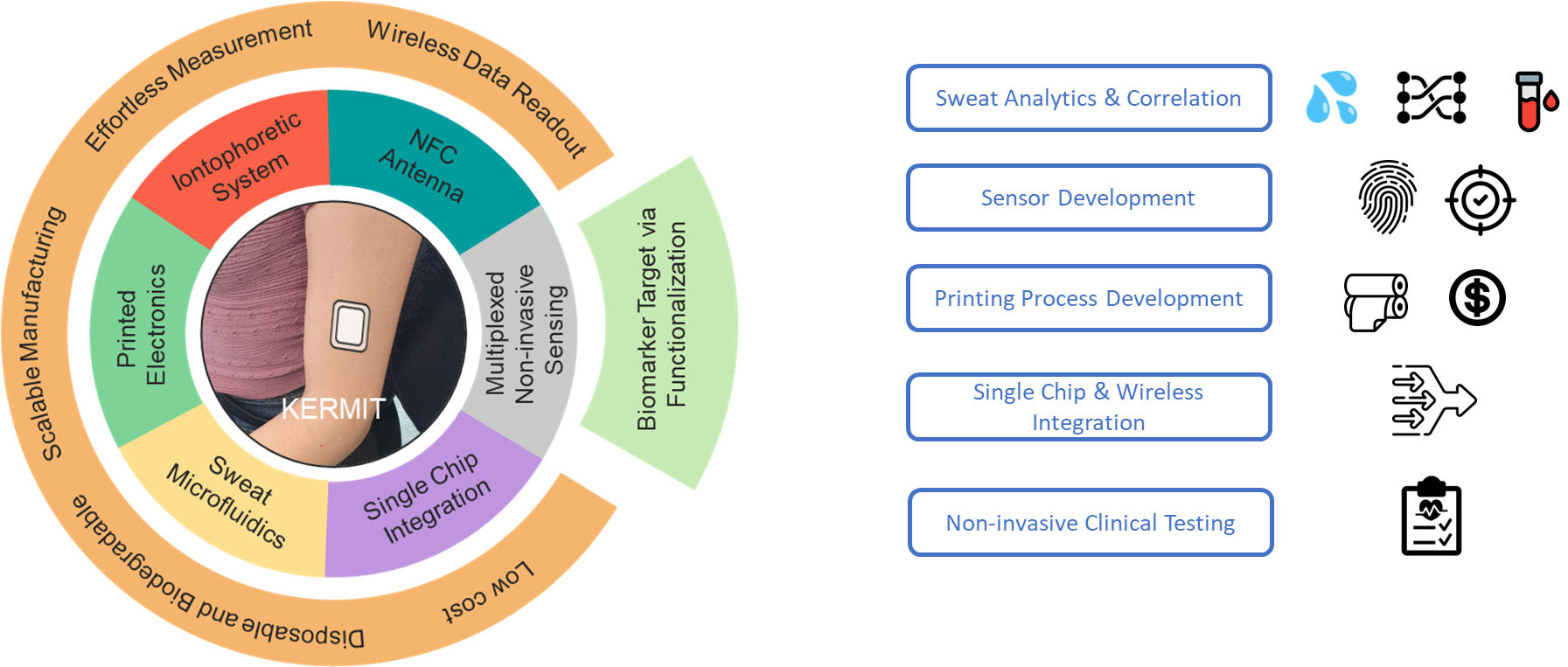About
KERMIT aims to revolutionize personalized healthcare through a simplified wearable analytic platform that can diagnose and monitor chronic kidney disease from sweat.
Project Description
KERMIT stands for Kidney Disease Sweat sensor patch for Early diagnosis and Remote MonIToring. It is a flagship project funded by the EIC Pathfinder Challenge: Towards the Healthcare continuum.
KERMIT’s aim is to develop a scalable platform for sweat-based sensorics to serve as a base for unobtrusive point-of-care diagnostics of kidney disease, transferable to other diseases. This can be done via integration of multiple analyte sensors with a sweat collection system and a low-power analysis and wireless data transmission chip into a simple-to-use disposable on-skin patch that can be easily dispatched by doctors and applied by patients to screen at-risk populations and monitor chronic diseases remotely.
The highlight features of KERMIT are the simplification of supporting electronics to a single chip and the use of environmentally friendly printable materials, facilitating its adaptation for low-cost mass manufacturing. The ease-of-access in combination with simplified patient-oriented usage protocols will facilitate the transition from a reactive testing model to a preventive monitoring approach.
KERMIT’s platform is supported by 3 main objectives:
Creating a reference base for remote diagnosis based on the relationship between biomarkers in sweat, biomarkers in blood, and kidney disease.
Providing reliable electrochemical sensing mechanisms for kidney disease biomarkers realised on printed sensors minimising false positives via multi-analyte detection
Devising a low cost and versatile patch for unobtrusive measurements of biomarkers, designed to be seamlessly integrated into patients’ lives.
The KERMT projec’s breakthrough technologies will depend on the synergy between 5 disciplines: nephrology impact validation, novel immunosensing techniques, high throughput printed electronics, CMOS technology integration, and patient perspective driven design. Each of KERMIT’s objectives is addressed in a multidisciplinary manner that feeds of the expertise of each partner to provide complimentary solutions for each challenge and component of the proposed system.
Vision
Simplified integrated lab-on-chip system in a patch form
Fast and reliable advanced detection of Kidney disease biomarkers based on nephrology studies
Use of sustainable materials for easy disposal
Low-cost
No external power
Uncomplicated user interface (for patients and medical experts)
EIC Pathfinder Challenge
Kermit is part of the EIC Pathfinder Challenge: Towards the Healthcare Continuum: technologies to support a radical shift from episodic to continuous healthcare. The objectives to be tackled by KERMIT within this challenge are:
Develop a novel technology (device, instrument or full system)for unobtrusive proactive healthcare.
Offer life-long health status monitoring and elements of predictive medicine with methodologies grounded in existing scientific evidence.
Provide adequate safety and performance, while paying attention to minimising false positives that could hamper its real-world use.
Make the case for a clinically acceptable solution amenable to successful evaluation under common Health Technology Assessment (HTA) methodologies;
Provide a path to future integration in the European healthcare workflow, specifically in relation to the inter-operability with existing infrastructures, as well as take up and compliance by appropriate patient populations, should be plausible.
Through these objectives, KERMIT s expected to support the transition from episodic and symptom-triggered healthcate towards a continuos and preventive healthcare. In this manner individuals can beaccompanied continuously and unobtrusively by health monitoring technology and practitioners, proactively offering diagnosis, treatment or follow up at the optimal pace and with optimal protocols as dictated by clinical evidence.



